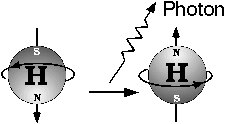 15
15
The nucleus of a Hydrogen atom is represented here. Its quantum property, spin, changes state as it emits a photon to its surroundings.
Introduction
This page covers the three basic processes that occur after a nucleus has absorbed energy and its state is changed. See the previous page for the basics of MRI physics and a description of the Larmor frequency.
Absorbed RF Energy is EmittedNuclei that have absorbed the radio frequency energy will not remain in their excited state for a long time. They return to their initial state, emitting a radio frequency signal to their surroundings. These signals are picked up by detectors that are placed all around the body. The signals are then compiled using Computed Tomography techniques into an image. The following two nuclear processes are used to assemble a MRI.
When a nucleus absorbs a photon at its Larmor frequency, its spin state changes. However the nucleus will not stay in this state. It will return to its original state after emitting a photon. The time it takes to do this is called the spin-lattice relaxation time, and is given by the constant T1. This process is demonstrated in the picture below:
 15
15
The nucleus of a Hydrogen atom is represented here. Its quantum property, spin, changes state as it emits a photon to its surroundings.
Another type of relaxation used in magnetic resonance imaging is spin-spin relaxation. Because the magnetic field varies, the nuclei's Larmor frequency will vary. Since they spin at different frequencies, the nuclei will gradually end up out of phase, or spin at different times. MRIs use the loss of signal due to the phase-difference between these nuclei to assist in creating the image; however this type of relaxation is too complicated for us to explore in detail.
For more information on spin-spin relaxation, visit Simply Physics: The Home of MRI Physics Put Simply.
More detailed explanations are available for the physics of MRIs. See our links page for exceptional sources for explaining MRI physics in more detail.
A more detailed explanation of the Larmor frequency, created by the Chemistry Department at Queens University, is found at the link.
Check Your Understanding
What is the relationship between the magnetic field and νL?
A. νL = γ / B
B. νL * γ = B
C. νL = γ * B
What are the two types of relaxation times used by MRIs?
A. spin-longitudinal, spin-transversal
B. longitudinal, transversal
C. spin-lattice, spin-spin
Spin-spin relaxation uses what to create MRI's? (Hint: It is used by MRI's to develop an image)
A. gain of signal due to phase-difference
B. loss of signal due to phase-difference
C. frequency emitted by the nucleus